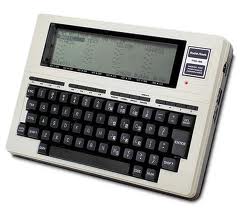
I’m upgrading my FIOS internet service tomorrow. Currently I’m on a 35/35 fiber connection and tomorrow Verizon will be upgrading to a 150 Verizon Quantum connection.
This involves replacing the router, changing the coaxial cable in the house to ethernet, changing the outside box at the house and then working on the box on the pole at the street. My involvement may be necessary so I might not be available to post. If I am available, I can use my Verizon 4G iPad to tether to my computer so I can work away while my home internet is down. We’ll see what happens.
I remember when I started all this stuff and used an acoustic coupler to access bulletin boards at 300 baud to my Radio Shack Model 100 battery powered portable computer. Even the Bell Labs people I worked with were impressed!! You have no idea how exciting that was! Then I gradually moved up to a 14.4Kbs modem, a 28Kbs modem and the end-all-and-be-all the fantastic 56Kbps modem that made me the fastest kid on the block! The best modems, then, were always from US Robotics – who bought Palm at one point.
For anyone who is doing this sort of upgrade, just a word of caution. You will never get the speeds you hope for. This is not because you don’t have the broadband connection, it is because you often have such a fast connection that you can suck stuff down faster than the servers you are connecting to can provide it. Always remember that the sending side has it’s own limitations depending on their traffic and configuration. Bottlenecks on the providing side are common. Nevertheless, even my 35/35 connection is sometimes enough to take my breath away.

Here’s a picture of the Model 100. It was powered by AA batteries and was the unheralded precursor of all our portable computers. Way ahead of its time. I did all sorts of stuff with this when I was at AT&T.
For those who don’t know what acoustic cups are, they were the beginning of telephonic computer communication. Your computer translated its output to sounds that were played through one cup which was placed over the telephone mike. The other cup was placed over the telephone recieiver to get the signal from the other end. Both cups usually had a soft rubber around them to seal nicely against the handset. It was quite a problem when new phones, such as the Princess phone, were introduced, because the cups didn’t fit around the fancy handset. Eventually these were replaced by the modem (short for “modulator/demodulator”) which obsoleted the cups.
Now that I think about it, acoustics were important in another area as well. When I worked at EBASCO, an engineering company that designed and built nuclear power plants (which was on the 93rd floor of the World Trade Center!!!!), we has a special facsimile room. In this room were a bank of machines that were basically rotating drums. You took a piece of paper and wrapped it around the drum, which would then start to spin. An optical pickup would scan the paper, convert the scan to acoustics and send it off to the receiving machine at the other end. It was absolutely amazing that we could transmit an 8 1/2 x 11 page in only half an hour!!! This was, of course, if the phone lines were clean. Sometimes it took a bit longer. I remember I sent a 20 page contract to Athens, Greece, in only 12 hours. Even with the phone charges it was a lot cheaper than hiring a courier to hand carry it. I’ve searched through Google Images but can’t find a picture to show you.
I’m sure that there were other analog acoustic appliances out there in the ’70s. Anyone old enough to remember things I’ve forgotten?






























When I went tracelling around Europe for 2 months in 1999, I used the PocketMail service to send and get email. I had a little clamshell device with an accoustic coupler in the back. You’d type your messages, go find a phone, dial a toll-free number, and at the prompt, hold the little gizmo up to the phone and it would exchange a bunch of beeps, boops and static. Pretty nifty in its retro way.